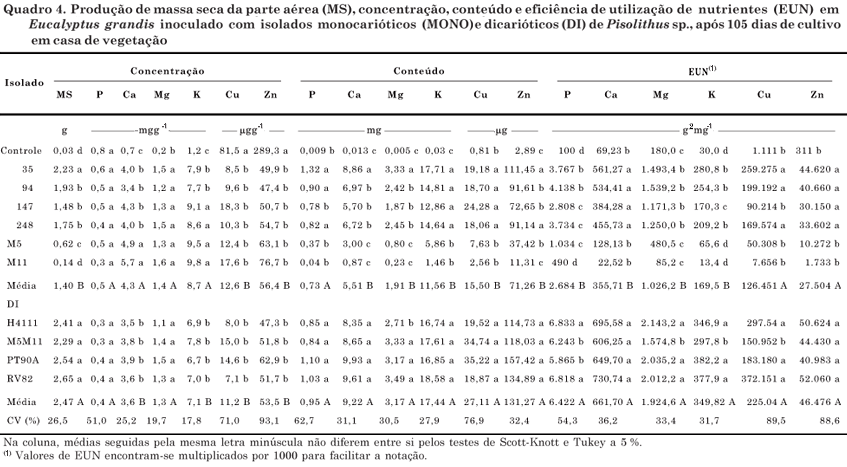The germination of Pisolithus spp. basidiospores originates monokaryons, characterized by having a single haploid nucleus per cell. In the field, eucalypts are associated with dykaryons of Pisolithus spp., there being no reports on the capacity of monokaryons to establish the ectomycorrhizal association with the host plant under such conditions. Although Pisolithus spp. monokaryons have been shown to form ectomycorrhizas in vitro, there is no information on the ability of these strains to promote nutrient uptake and growth of eucalypts. The objective of this study was to investigate the formation of ectomycorrhizae by monokaryotic and dikaryotic isolates of Pisolithus sp. in Eucalyptus grandis under greenhouse conditions, and the relationships between the establishment of ectomycorrhizae and the host plant growth and uptake of P, Ca, Mg, K, Cu, and Zn. The fungal isolates were highly variable in dry mycelial mass production and in their ability to take up macro- and micronutrients. Generally, the nutrient use efficiency of monokaryons was higher than that of dikaryons. All tested monokaryotic and dikaryotic isolates were able to form typical ectomycorrhizae when associated with E. grandis. The presence of monokaryotic isolates associated with the lateral roots of E. grandis resulted in typical increases in the radial diameter of the root epidermal cells, characteristic of eucalypt ectomycorrhizae, indicating that monokaryons, similarly to dikaryons, are capable of producing growth regulator compounds. The mean root colonization percentage of the monokaryotic and dikaryotic isolates varied from 12 to 76 %. The Ca, K, and Mg uptake was highly stimulated by the presence of ectomycorrhizae, with up to 760-fold increases, suggesting that the association must play a significant role in supplying the host with these nutrients, especially Ca. Some monokaryotic isolates are as efficient as the dikaryons at promoting root colonization and nutrient uptake. The characterization of Pisolithus sp. monokaryons is a basic requirement for the selection and crossing of isolates with desirable traits, aiming at the genetic improvement of fungal strains and a higher efficiency of the ectomycorrhizal association. This is the first report on the nutritional interactions between Pisolithus sp. monokaryons and the host plant.
macronutrients; micronutrients; compatibility; plant nutrition








